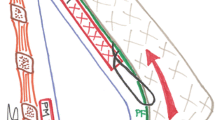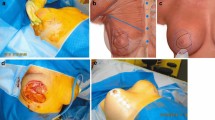Abstract
Background
The technique of muscle splitting biplane breast augmentation associated with internal mastopexy to correct breast hypoplasia, ptosis and asymmetry was reported in 2014. The purpose of this article is to present recent modifications and results of this technique.
Methods
Since 2016, 30 patients with breast hypoplasia associated with excessive or loose skin envelope or breast ptosis grade I have benefited from a new and improved technique of internal suture mastopexy combined with the muscle splitting biplane breast augmentation (muscle splitting biplane breast augmentation with internal mastopexy type II or MSBBA-IM2).
Results
Excellent long-term results have been obtained by using the muscle splitting biplane breast augmentation with internal mastopexy type II, which maintains a natural breast shape and a smooth transition between the soft tissue and implant in the upper pole by redraping the breast parenchyma both at the level of the upper pole and at the level of the lower pole of the breast.
Conclusions
The new technique of muscle splitting biplane breast augmentation with internal mastopexy type II or MSBBA-IM2 offers improved long-term aesthetic results and is an effective alternative in selected patients requiring correction of breast hypoplasia associated with excessive or loose skin envelope or breast ptosis grade I.
Level of Evidence IV
Level of Evidence IV This journal requires that authors assign a level of evidence to each article. For a full description of these Evidence-Based Medicine ratings, please refer to the Table of Contents or the online Instructions to Authors www.springer.com/00266.








Similar content being viewed by others
References
Cronic TD, Gerow RM (1964) Augmentation mammoplasty: new “natural feel” prosthesis. In the translation of the third international congress of the plastic surgery. Excerpta Medica International Congress Series, no 66, Excerpta Medica, Amsterdam, pp 41–49
Dempsey WC, Latham WD (1968) Subpectoral implants in augmentation mammoplasty: a preliminary report. Plast Reconstr Surg 42:515–521
Regnault P (1977) Partially submuscular breast augmentation. Plast Reconstr Surg 59:72–76
Tebbetts JB (2001) Dual-plane breast augmentation: optimizing implant-soft tissue relationship in a wide range of breast types. Plast Reconstr Surg 107:1255–1272
Graf RM, Bernardes A, Rippel R et al (2003) Subfascial breast implant: a new procedure. Plast Reconstr Surg 111:904–908
Sampaio Goes JC, Landecker A (2003) Optimizing outcomes in breast augmentation: seven years experience with the subfascial plane. Aesthetic Plast Surg 27:178–184
Barbato C, Pena M, Triana C et al (2004) Augmentation mammoplasty using the retrofascia approach. Aesthetic Plast Surg 28:148–152
Baxter RA (2005) Subfascial breast augmentation: theme and variations. Aesthetic Surg J 25:447–453
Siclovan HR, Jomah JA (2008) Advantages and outcomes in subfascial breast augmentation: a two-year review of experience. Aesthetic Plast Surg 32:426–431
Tijerina VNE, Saenz RAE, Garcia-Guerrero J (2010) Experience of 1000 cases on subfascial breast augmentation. Aesthetic Plast Surg 34:16–22
Khan UD (2007) Muscle-splitting breast augmentation: a new pocket in a different plane. Aesthetic Plast Surg 31:553–558
Khan UD (2009) Dynamic breasts: a common complication following partial submuscular augmentation and its correction using the muscle-splitting biplane technique. Aesthetic Plast Surg 33:353–360
Lang Stümpfle R, Pereira-Lima LF, Alves Valiati A et al (2012) Transaxillary muscle-splitting breast augmentation: experience with 160 cases. Aesthetic Plast Surg 36:343–348
Siclovan HR (2015) Versatility of muscle splitting biplane technique associated with internal mastopexy in breast hypoplasia, ptosis and asymmetry. Eur J Plast Surg 38:37–42
Mahabir RC, Zamboni WA (2008) A new technique of internal suture mastopexy for mild to moderate breast ptosis. Can J Plast Surg 16(1):11–13
Khan UD (2011) Multiplane technique for simultaneous submuscular breast augmentation and internal glandulopexy using inframammary crease incision in selected patients with early ptosis. Eur J Plast Surg 34:337–343
Mallucci P, Branford OA (2016) Design for natural breast augmentation: the ICE principle. Plast Reconstr Surg 137:1728–1737
Tebbetts JB, Adams W (2006) Five critical decisions in breast augmentation using five measurements in 5 minutes: the high five decision support process. Plast Reconstr Surg 118(Suppl):35S–45S
Tebbets JB (2002) Breast implants selection based on patient tissue characteristics and dynamics: the TEPID approach. Plast Reconstr Surg 190:1396–1409
Adams WP, Culbertson EJ, Deva AK et al (2017) Macrotextured breast implants with defined steps to minimize bacterial contamination around the device: experience in 42,000 implants. Plast Reconstr Surg 140:427–431
Author information
Authors and Affiliations
Corresponding author
Ethics declarations
Conflict of interest
The authors declare that they have no conflict of interest to disclose.
Human and Animal Rights
This article does not contain any studies with human participants or animals performed by any of the authors.
Informed Consent
For this type of study, informed consent is not required.
Additional information
Publisher's Note
Springer Nature remains neutral with regard to jurisdictional claims in published maps and institutional affiliations.
Rights and permissions
About this article
Cite this article
Şiclovan, H.R., Nistor, P. Modified Internal Mastopexy Technique in Muscle Splitting Biplane Breast Augmentation. Aesth Plast Surg 44, 716–725 (2020). https://doi.org/10.1007/s00266-019-01597-x
Received:
Accepted:
Published:
Issue Date:
DOI: https://doi.org/10.1007/s00266-019-01597-x




